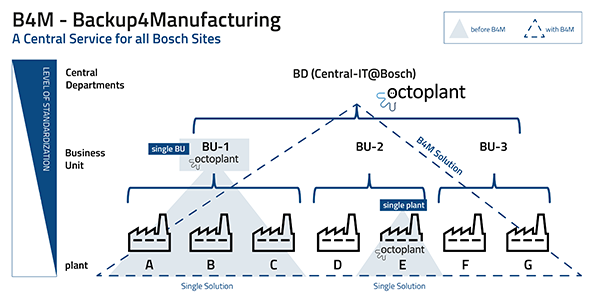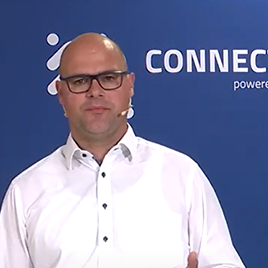Backup for Manufacturing (B4M): A Service for All Global Bosch Locations
Reducing maintenance work: how Bosch uses octoplant to provide central standards for production facilities
Initial Situation
Today’s production facilities are made up of different machines and systems made by a wide range of manufacturers. And Bosch’s are no exception. Bosch has an enormous range of operative technologies and associated production processes, from fully automated production lines for high-volume products with a lot of equipment and cycle times that last for mere seconds, all the way to products whose components need to be assembled manually, which can take several minutes. Up to now, Bosch has used AUVESY-MDT’s “versiondog” – the predecessor of octoplant – locally in some areas. All of Bosch’s plants throughout the world were themselves responsible for introducing, installing, servicing, and utilizing the product as efficiently as they could. But there was no global solution that combined process and data management for all of the locations, to be managed centrally by IT.

The Solution
On the basis of experience gathered through years of using octoplant at different locations worldwide, an integrated service was developed that builds on the existing software. The aim of the solution: practical IT-OT convergence and more productive collaboration within the different units, from infrastructure and installation, to onboarding, to license management, with the intention of optimizing local processes and procedures, thereby increasing overall efficiency.
“At Bosch we think in terms of end-to-end-services. This encompasses the whole life cycle and everything connected to the product, and that goes for the B4M service as well. At the heart of the service is octoplant.” Oliver Müller, Senior Manager at Bosch Digital
A service that can be used by all of the production sites and business units worldwide, and which is monitored and developed by the central IT department. The aim was to make it easy to understand and intuitive to operate, so that systems would be easy to service. The manufacturing teams were defined as the main user group, who could then concentrate exclusively on improving manufacturing processes.
Based on their analysis, the IT team at Bosch opted for a centralized service with octoplant at its heart, and called it “Backup for Manufacturing” (B4M). This has since enabled transparency across the board and the execution of all production procedures in every trans-locational backup and recovery process, as well as global system management.

B4M – which has octoplant at its heart – brings Bosch one big step closer to the digital factory. We’ve increased efficiency significantly by providing standardized machine optimization at all of our production sites.

The Result
Manual servicing work has been greatly reduced by introducing the system throughout the Group, while complying with stringent IT security demands. This means production managers can now focus on optimizing procedures, since IT issues such as installation and license management are taken care of.
“We have plants all over the world manufacturing the same product. This means they have the same equipment and should be able to access the same data and versions.” Oliver Müller, Senior Manager at Bosch Digital
Standardization begins at plant level, where initial experience is gathered. The next step will be the business units, and finally the central unit level, which will include the central IT unit, Bosch Digital (BD). A dedicated development team works there on improving B4M in day-to-day use. All of the business units can participate in the IT Requirement Management Board, which collates all of the new demands on the service. These form the basis for further development.
Every single production site has a local octoplant installation, while a central octoplant installation enables the delivery of standards. The synchronized delivery of a standardized component catalog ensures that everyone uses the same system components with standardized IDs. When the development team develops a new script, it is distributed to all of the Bosch locations, and every production manager has access to the latest compatible version. Standardization also creates a template structure which enables new plants to be integrated quickly and reliably into the system. Existing machines can also be relocated smoothly by digitally cloning the system as a backup using B4M. Central reports are automatically drawn up for every location, helping developer teams to evaluate global production and raise it to the next level.
“Once we’ve identified a problem, we can solve it for everybody. And once that has happened, we synchronize the new version centrally with all of the localized octoplant installations and ensure that everyone benefits from the new solution.” Oliver Müller, Senior Manager at Bosch Digital
There is also a comprehensive knowledge management and training system available for all of our training courses, which was delivered by AUVESY-MDT specially for Bosch’s needs. The service further includes security aspects of network segmenting, such as an authorization concept and IAM (Identity and Access Management). If a plant improves a machine in the production process, a new version of this machine is made available in the international production network, so that all of the plants can benefit from the improvement. The same applies to defects and faults. As soon as a fault occurs in a machine and is resolved at one location, the whole network can access the fault-free version. This means local knowledge is disseminated worldwide and all of the shop floors are optimized.
How Does Network Segmenting Work at Bosch?
Bosch has defined digital firewall rules in order to keep control of which users, ports, and protocols are used in the network environment. To this end, the network was divided into the following zones: all of the production facilities are located in their own production zone, which the production location monitors and manages. octoplant servers and agents are each in a separate zone. If a user of the “normal” network initiates a job by means of the user client, the server sends this to the octoplant agent through the firewall. The agent in turn sends the data from the production zone through the firewall, collects the data, creates a backup copy, and sends it back to the octoplant server so that the user can see the results in the user client. This allows high levels of standardization and security.
Contact us
Want to learn more about automatic backups, versioning and documentation in automated production?
Contact us

